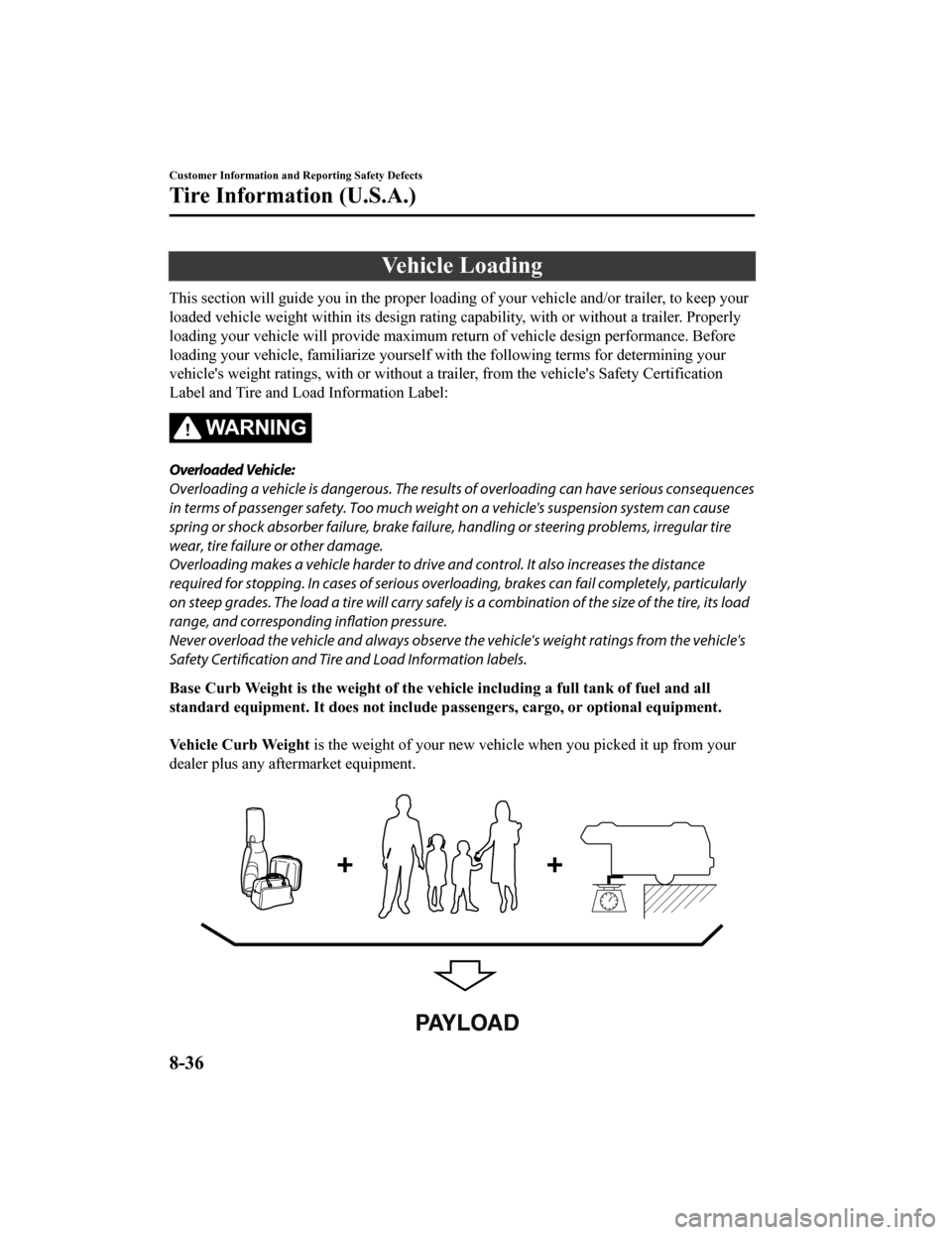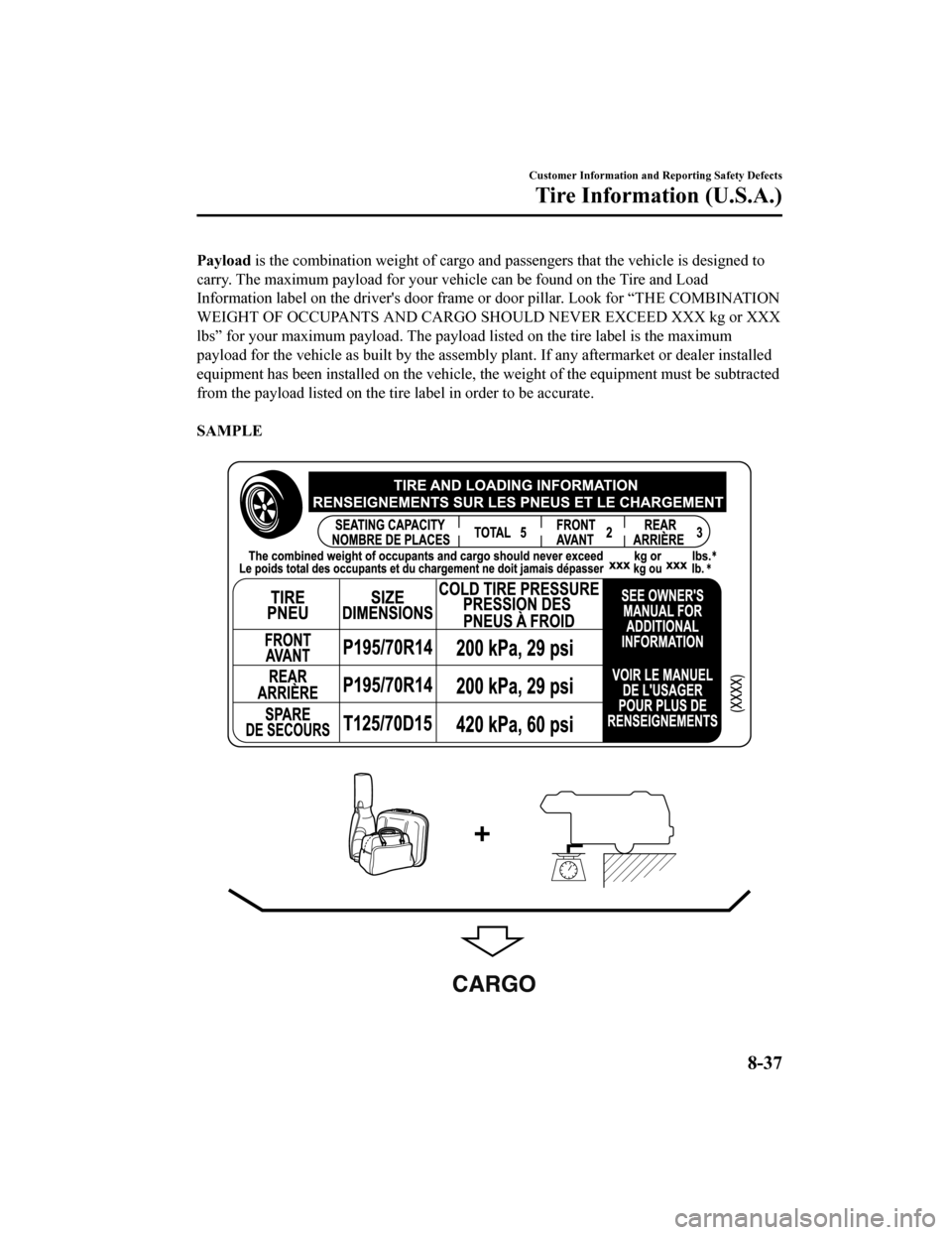weight MAZDA MODEL CX-9 2020 (in English) Owner's Manual
[x] Cancel search | Manufacturer: MAZDA, Model Year: 2020, Model line: MODEL CX-9, Model: MAZDA MODEL CX-9 2020Pages: 706
Page 624 of 706

NOTE
To allow the front passenger occupant
classification sensor to function
properly, do not place and sit on an
additional seat cushion on the front
passenger's seat. The sensor may not
function properly because the additional
seat cushion could cause sensor
interference.
If a small child is seated on the front
passenger's seat, the warning beep may
not operate.
Mexico
If the vehicle speed exceeds about 20
km/h (12 mph) with the driver or front
passenger's seat belt unfastened, a warning
beep sounds continuously. If the seat belt
remains unfastened, the beep sound stops
once and then continues for about 90
seconds. The beep stops after the driver or
front passenger's seat belt is fastened.
Until a seat belt is fastened or a given
period of time has elapsed, the beep sound
will not stop even if the vehicle speed falls
below 20 km/h (12 mph).
NOTE
Placing heavy items on the front
passenger's seat may cause the front
passenger's seat belt warning function
to operate depending on the weight of
the item.
To allow the front passenger seat weight
sensor to function properly, do not place
and sit on an additional seat cushion on
the front passenger's seat. The sensor
may not function properly because the
additional seat cushion could cause
sensor interference.
If a small child is seated on the front
passenger's seat, the warning beep may
not operate.
Rear seat
*
The warning beep only sounds if a seat
belt is unfastened after being fastened.
▼ Ignition Not Switched Off (STOP)
Warning Beep
If the driver's door
is opened with the
ignition switched to ACC, a beep will be
heard continuously in the cabin to notify
the driver that the ignition has not been
switched OFF (STOP). Under this
condition, the keyless entry system will
not operate, the vehicle cannot be locked,
and the battery voltage will be depleted.
▼ Key Removed from Vehicle Warning
Beep
Vehicles with advanced keyless function
If the key is taken out of the vehicle while
the ignition is not switched OFF and all
the doors are closed, the beep which
sounds outside of the vehicle will be heard
6 times, the beep which sounds inside the
vehicle will be heard 6 times.
Vehicles without advanced keyless
function
If the key is taken out of the vehicle while
the ignition is not switched OFF and all
the doors are closed, a
beep will be heard
in the cabin 6 times.
NOTE
Because the key utilizes low-intensity
radio waves, the Key Removed From
Vehicle Warning may activate if the key is
carried together with a metal object or it
is placed in a poor signal reception area.
If Trouble Arises
Warning/Indicator Lights and Warning Sounds
7-48*Some models.
CX-9_8HT8-EA-19I_Edition2_old 2019-9-24 13:14:55
Page 656 of 706

P215/65R15 95H is an example of a tire size and load index rating. Here is an explanation
of the various components of that tire size and load index rating. Note that the tire size and
load index rating may be different from the example.
P
Indicates a tire that may be installed on cars, SUVs, minivans and light trucks as designated
by the Tire and Rim Association (T&RA).
NOTE
If your tire size does not begin with a letter this may mean it is designated by either ETRTO
(European Tire and Rim Technical Organization) or JATMA (Japan Tire Manufacturing
Association).
215
“215” is the nominal width of the tire in m illimeters. This three-digit number gives the
width in millimeters of the tire from sidewall edge to sidewall edge. In general, the larger
the number, the wider the tire.
65
“65” is the aspect ratio. This two-digit number indicates the tire's ratio of height to width.
R
“R” is the tire construction symbol. R indicates “Radial ply construction”.
15
“15” is the wheel rim diameter in inches.
95
“95” is the Load Index. This two-or three-digit number indicates how much weight each tire
can support.
H
“H” is the speed rating. The speed rating denotes the maximum speed for which the use of
the tire is rated.
Letter Rating Speed Rating
Q9 9 m ph
R1 06 m ph
S 112 mph
T 118 mph
U1 24 m ph
H1 30 m ph
Customer Information and Reporting Safety Defects
Tire Information (U.S.A.)
8-26
CX-9_8HT8-EA-19I_Edition2_old 2019-9-24 13:14:55
Page 657 of 706

Letter RatingSpeed Rating
V1 49 m ph
W 168
* mph
Y 186
* mph
* For tires with a maximum speed capability over 149 mph, tire manufacturers sometimes use the letters ZR. For
tires with a maximum speed capability over 186 mph, tire manufacturers always use the letters ZR.
MS or M/S: Mud and Snow
AT: All Terrain.
AS: All Season. The “M
S” or “M/S” indicates that the tire has some functional use in mud
and snow.
U.S. DOT Tire Identification Number (TIN)
This begins with the letters “DOT” which indicates the tire meets all federal standards. The
next two numbers or letters are the plant code where it was manufactured, and the last four
numbers represent the week and year the tire was manufactured. For example, the numbers
457 means the 45st week of 1997. After 2000 the numbers go to four digits. For example,
the number 2102 means the 21th week of 2002. The other numbers are marketing codes
used at the manufacturer's discretion. This information is used to contact consumers if a tire
defect requires a recall.
Tire Ply Composition and Materials Used
The number of plies indicates the number of layers of rubber-coated fabric in the tire. In
general, the greater the number of plies, the more weight a tire can support. Tire
manufacturers also must indicate the tire mate rials, which include steel, nylon, polyester,
and other.
Maximum Load Rating
This number indicates the maximum load in kilograms and pounds that can be carried by the
tire.
Maximum Permissible Inflation Pressure
This number is the greatest amount of air pressure that should ever be put in the tire under
normal driving conditions.
Tread Wear, Traction and Temperature Grades
Tr e a d w e a r : The tread wear grade is a comparative rating based on the wear rate of the tire
when tested under controlled conditions on a specified government test course. For
example, a tire graded 150 would wear one and one-half (1 1/2) times as well on the
government course as a tire graded 100.
Customer Information and Reporting Safety Defects
Tire Information (U.S.A.)
8-27
CX-9_8HT8-EA-19I_Edition2_old 2019-9-24 13:14:55
Page 659 of 706

1. Temporary tires
2. Nominal width of tire in millimeters
3. Ratio of height to width (aspect ratio)
4. Diagonal
5. Rim diameter code
6. Load index & speed symbol
T115/70D16 90M is an example of a tire size and load index rating. Here is an explanation
of the various components of that tire size and load index rating. Note that the tire size and
load index rating may be different from the example.
T
Indicates a tire that may be installed on cars, SUVs, minivans and light trucks as designated
by the Tire and Rim Association (T&RA).
11 5
“115” is the nominal width of the tire in mi llimeters. This three-digit number gives the
width in millimeters of the tire from sidewall edge to sidewall edge. In general, the larger
the number, the wider the tire.
70
“70” is the aspect ratio. This two-digit number indicates the tire's ratio of height to width.
D
“D” is the tire construction symbol. D indicates “diagonal ply construction”.
16
“16” is the wheel rim diameter in inches.
90
“90” is the Load Index. This two-or three-digit number indicates how much weight each tire
can support.
M
“M” is the speed rating. The speed rating denotes the maximum speed for which the use of
the tire is rated.
Letter Rating Speed Rating
M8 1 m ph
Customer Information and Reporting Safety Defects
Tire Information (U.S.A.)
8-29
CX-9_8HT8-EA-19I_Edition2_old 2019-9-24 13:14:55
Page 661 of 706

WA R N I N G
Always check the tire inflation pressures on a regular basis according to the recommended
tire inflation pressure on the tire label and in conjunction with the information in this owner's
manual:
Driving your vehicle with under-inflated tires is dangerous.
Under-inflation is the most common cause of failures in any kind of tire and may result in
severe cracking, tread separation or “blowout”, with unexpected loss of vehicle control and
increased risk of injury. Under-inflation inc reases sidewall flexing and rolling resistance,
resulting in heat buildup and internal damage to the tire. It results in unnecessary tire stress,
irregular wear, loss of control and accidents. A ti re can lose up to half of its air pressure and
not appear to be flat!
It is impossible to determine whether or not tires are properly inflated just by looking at them.
▼Checking Tire Pressure
1. When you check the air pressure, make sure the tires are cold
―meaning they are not
hot from driving even a mile.
2. Remove the cap from the valve on one tire.
3. Firmly press a tire gauge onto the valve.
4. Add air to achieve recommended air pressure.
5. If you overfill the tire, release air by push ing on the metal stem in the center of the
valve. Then recheck the pressure with your tire gauge.
6. Replace the valve cap.
7. Repeat with each tire, including the spare.
NOTE
Some spare tires require higher inflation pressure.
8. Visually inspect the tires to make sure there are no nails or other objects embedded that
could poke a hole in the tire and cause an air leak.
9. Check the sidewalls to make sure there are no gouges, cuts, bulges, cracks or other irregularities.
▼Glossary of Terms
Tire Placard:
A label indicating the OE tire sizes, recommended inflation pressure, and the
maximum weight the vehicle can carry.
Tire Identificatio n Number (TIN): A number on the sidewall of each tire providing
information about the tire brand and manufacturi ng plant, tire size, and date of manufacture.
Inflation Pressure: A measure of the amount of air in a tire.
kPa: Kilopascal, the metric unit for air pressure.
psi: Pounds per square inch, the English unit for air pressure.
B-pillar: The structural member at the side of the vehicle behind the front door.
Customer Information and Reporting Safety Defects
Tire Information (U.S.A.)
8-31
CX-9_8HT8-EA-19I_Edition2_old 2019-9-24 13:14:55
Page 662 of 706

Original Equipment (OE): Describes components originally equipped on the vehicle.
Vehicle Load Limit: The maximum value of the combination weight of occupants and
cargo.
Bead Area of the Tire: Area of the tire next to the rim.
Sidewall Area of the Tire: Area between the bead area and the tread.
Tread Area of the Tire: Area on the perimeter of the tire that contacts the road when it's
mounted on the vehicle.
Seating capacity means the total allowable number of vehicle occupants. Seating capacity
is described on the tire label.
Production options weight is the combination weight of installed regular production
options weighing over 2.3 kilograms in excess of the standard items which they replace, and
not previously considered in the curb weight or accessory weight, including heavy duty
brakes, ride levelers, roof rack, heavy duty battery, and special trim.
Rim is the metal support (wheel) for a tire or a tire and tube assembly upon which the tire
beads are seated.
Customer Information and Reporting Safety Defects
Tire Information (U.S.A.)
8-32
CX-9_8HT8-EA-19I_Edition2_old 2019-9-24 13:14:55
Page 666 of 706

Ve h i c l e L o a d i n g
This section will guide you in the proper loading of your vehicle and/or trailer, to keep your
loaded vehicle weight within it s design rating capability, with or without a trailer. Properly
loading your vehicle will provide maximum return of vehicle design performance. Before
loading your vehicle, familiarize yourself with the following terms for determining your
vehicle's weight ratings, with or without a trailer, from the vehicle's Safety Certification
Label and Tire and Load Information Label:
WA R N I N G
Overloaded Vehicle:
Overloading a vehicle is dangerous. The results of overloading can have serious consequences
in terms of passenger safety. Too much weight on a vehicle's suspension system can cause
spring or shock absorber failure, brake failu re, handling or steering problems, irregular tire
wear, tire failure or other damage.
Overloading makes a vehicle harder to drive an d control. It also increases the distance
required for stopping. In cases of serious overloading, brakes can fail completely, particularly
on steep grades. The load a tire will carry safely is a combination of the size of the tire, its load
range, and corresponding inflation pressure.
Never overload the vehicle and always observe th e vehicle's weight ratings from the vehicle's
Safety Certification and Tire and Load Information labels.
Base Curb Weight is the weight of the ve hicle including a full tank of fuel and all
standard equipment. It does not include passengers, carg o, or optional equipment.
Vehicle Curb Weight is the weight of your new vehicl e when you picked it up from your
dealer plus any aftermarket equipment.
PAYLOAD
Customer Information and Reporting Safety Defects
Tire Information (U.S.A.)
8-36
CX-9_8HT8-EA-19I_Edition2_old 2019-9-24 13:14:55
Page 667 of 706

Payload is the combination weight of cargo and pa ssengers that the vehicle is designed to
carry. The maximum payload for your vehicl e can be found on the Tire and Load
Information label on the driver's door frame or door pillar. Look for “THE COMBINATION
WEIGHT OF OCCUPANTS AND CARGO SHOULD NEVER EXCEED XXX kg or XXX
lbs” for your maximum payload. The payload listed on the tire label is the maximum
payload for the vehicle as built by the assembly plant. If any aftermarket or dealer installed
equipment has been installed on the vehicle, the weight of the equipment must be subtracted
from the payload listed on the tire label in order to be accurate.
SAMPLE
CARGO
Customer Information and Reporting Safety Defects
Tire Information (U.S.A.)
8-37
CX-9_8HT8-EA-19I_Edition2_old 2019-9-24 13:14:55
Page 668 of 706

Cargo Weight includes all weight added to the Base Curb Weight, including cargo and
optional equipment. When towing, trailer tongue load or king pin weight is also part of
cargo weight.
The cargo weight limit decreases depending on the number of vehicle occupants. The cargo
weight limit can be calculated by subtracting the total weight of the vehicle occupants from
the “combination weight of occupants and cargo should never exceed” value on the tire
label.
Examples: Based on a single occupant weight of 68 kg (150 lbs), and a value of 385 kg (849
lbs) for the “combination weight of occupants and cargo should never exceed”:
The cargo weight limit with one occupant is 385 kg (849 lbs) - 68 kg (150 lbs) = 317 kg
(699 lbs)
The cargo weight limit with two occupants is 385 kg (849 lbs) - (68 × 2) kg ( (150 × 2)
lbs) = 249 kg (549 lbs)
If the weight of the occupant increases, the cargo weight limit decreases by that much.
GAW (Gross Axle Weight) is the total weight placed on each axle (front and rear) -
including vehicle curb weight and all payload.
GAWR (Gross Axle Weight Rating) is the maximum allowable weight that can be carried
by a single axle (front or rear). These numbers are shown on the Safety Compliance
Certification Label locate d on the driver's door frame or door pillar. Th e total load on
each axle must never exceed its GAWR.
GVW
GVW (Gross Vehicle Weight) is the Vehicle Curb Weight cargo passengers.
GVWR (Gross Vehicle Weight Rating) is the maximum allowable weight of the fully
loaded vehicle (including all options, equipment, passengers and cargo). The GVWR is
Customer Information and Reporting Safety Defects
Tire Information (U.S.A.)
8-38
CX-9_8HT8-EA-19I_Edition2_old 2019-9-24 13:14:55
Page 669 of 706

shown on the Safety Compliance Certification Label located on the driver's door
frame or door pillar. The GVW must never exceed the GVWR.
SAMPLE
WA R N I N G
Never Exceed Axle Weight Rating Limits:
Exceeding the Safety Certification Label axle weight rating limits is dangerous and could
result in death or serious injury as a result of substandard vehicle handling, performance,
engine, transmission and/or structural damage , serious damage to the vehicle, or loss of
control.
Always keep the vehicle within the axle weight rating limits.
GCW
Customer Information and Reporting Safety Defects
Tire Information (U.S.A.)
8-39
CX-9_8HT8-EA-19I_Edition2_old 2019-9-24 13:14:55